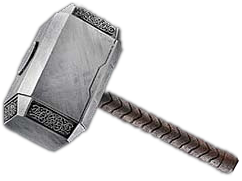Our goal is to construct a functor \(H_*\) from the category of topological spaces and continuous maps to the category of \(\ZZ\)-modules and \(\ZZ\)-linear maps.
This means to each space \(X\) we associate an abelian group \(H_*(X) = \bigoplus_{n\ge 0}H_n(X)\), and to each map \(f\colon X \to Y\) a function \(f_*\colon H_n(X) \to H_n(Y)\) satisfying \((1_X)_* = 1_{H_n(X)}\) and \((f\circ g)_* = f_* \circ g_*\).
Some properties we would like to have for our construction are:
- Homotopy invariance, if \(f \sim g \colon X \to Y\) then \(f_* = g_*\).
- The dimension axiom, \(H_n(X) = 0\) for any \(n > \dim X\).
Subsection1.3.1Chain complexes
Definition1.3.1Chain complex
If \(R\) is a commutative ring then a chain complex over \(R\) is a pair \((C,d)\) satisfying:
- \(C = \bigoplus_{n\in\ZZ} C_n\) for \(R\)-modules \(C_n\).
- \(d\colon C \to C\) where \(d = \bigoplus d_n\) for \(R\)-linear maps \(d_n\).
- \(d\circ d = 0\).
The indexing by \(n\) is called a grading.
Usually we take \(C_n = 0\) for \(n \lt 0\).
An element of \(\ker d_n\) is called closed or a cycle.
An element of \(\im d_n\) is called a boundary.
\(d\) is the boundary map or differential.
Definition1.3.2Homology groups
If \((C,d)\) is a chain complex, its \(n\)th homology group is
\[H_n(C,d) = \ker d_n/\im d_{n+1}.\]
If \(x \in \ker d_n\) we write \([x]\) for its image in \(H_n(C)\).
Example1.3.3
-
\(C_0 = C_1 = \ZZ\), \(C_i = 0\) otherwise,
\[
0\to \ZZ \xrightarrow{\cdot 3} \ZZ \to 0.
\]
Then \(H_1 = 0\), \(H_0 = \ZZ/3\).
-
\[
\ZZ=\langle e\rangle\to\ZZ^2 = \langle f_1,f_2\rangle\to\ZZ=\langle g\rangle \to 0
\]
with \(d(e) = f_1-f_2\), \(d(f_1) = d(f_2) = g\), then \(H_*(C) = 0\)(exercise).
Subsection1.3.2The chain complex of a simplex
Definition1.3.4\(n\)-simplex
The \(n\)-dimensional simplex\(\Delta^n\) is \[\Delta^n = \left\{ (x_0,\ldots,x_n)\in\RR^n : \sum_{i} x_i = 1,\, x_i \ge 0 \forall i\right\}.\]\(\Delta^n\) has vertices\(v_0,\ldots,v_n\) which are the intersections with the coordinate axes. The \(k\)-dimensional faces are in bijection with the \(k+1\)element subsets of \(\{0,\ldots,n\}\).
Definition1.3.5Simplicial chain complex
\(S_*(\Delta^n)\) is the chain complex with \(S_k(\Delta^n)\) the free \(\ZZ\)-module generated by the \(k\)-dimensional faces of \(\Delta^n\).
So
\[
S_k(\Delta^n) = \langle e_I : I = \{i_0,\ldots,i_k : 0 \le i_0 \le \cdots \le i_k \le n \}\rangle.
\]
To define \(d\) it suffices to define \(d(e_I)\), we let \[d(e_I) = \sum_{j = 0}^{k}(-1)^j e_{i_0,\ldots,i_{j-1}, i_{j+1},\ldots,i_k}\in S_{k-1}(\Delta^n).\]
Example1.3.6
- For \(\Delta^1\) we have \(d(e_{0,1}) = e_1 - e_0\).
- For \(\Delta^2\) we have \(d(e_{0,1,2}) = e_{12} - e_{02} + e_{01}\) and so \(d^2(e_{I} = (e_2 - e_1) - (e_2 - e_0) + (e_1 - e_0) = 0\).
Lemma1.3.7
\(d^2 = 0\)Proof
It suffices to show \(d^2(e_I) = 0\) for all \(I\).
\begin{align*}
d^2(e_I) &= d\left(\sum_{j = 0}^{k} (-1)^j e_{i_0,\ldots,\hat{i}_j,\ldots,i_k}\right)\\
&= \sum_{j = 0}^{k} (-1)^j d\left(e_{i_0,\ldots,\hat{i}_j,\ldots,i_k} \right)\\
&= \sum_{j = 0}^{k} (-1)^j\left( \sum_{l \lt j} (-1)^l e_{i_0,\ldots,\hat{i}_l,\ldots,\hat{i}_j,\ldots,i_k} + \sum_{l \gt j} (-1)^{l-1} e_{i_0,\ldots,\hat{i}_j,\ldots,\hat{i}_l,\ldots,i_k}\right)\\
&= \sum_{j = 0}^{k} \left( \sum_{l \lt j} (-1)^{l+j} e_{I - i_l - i_j} - \sum_{l \gt j} (-1)^{l+j} e_{I - i_j - i_l}\right) = 0.
\end{align*}
Example1.3.8Computing \(H_*(S_*(\Delta^2))\)
\[
0\to \ZZ = \langle e_{012}\rangle \to \ZZ^3 = \langle e_{01}, e_{02},e_{12}\rangle \to \ZZ^3 = \langle e_0,e_1,e_2 \rangle \to 0
\]
with \(d(e_{012}) = e_{12} - e_{02} + e_{01}\).
So \(\ker d_2 = 0 \implies H_2 = 0\).
\[
d(ae_{01} + be_{02} + ce_{12}) = a(e_1 - e_0) + b (e_2 - e_1) + c(e_2 - e_0)
\]
so \(ae_{01} + be_{02} + ce_{12}\in \ker d_1 \iff -a-b=0,\,a-c = 0,\, c+b = 0 \iff a = -b = c\) hence \(\ker d_1 = \langle e_{01} - e_{02} + e_{12} = \im d_2\) and so \(H_1 = 0\).
\(\ker(d_0) = 0\), \(\im d_1 = \langle e_1 - e_0, e_2 - e_1, e_2 - e_0\rangle\) so \(H_0 = \ZZ = \langle [e_0]\rangle\).
Exercise 1.3.9
Show that \(H_*(S_*(\Delta^n)) = 0\) if \(k \ne 0\) and \(\ZZ\) if \(k = 0\).
Subsection1.3.3The singular chain complex
Definition1.3.10Singular chain complex
If \(X\) is a space, the singular chain complex of \(X\), \(C_*(X)\) is defined by
\[C_n(x) = \langle e_\sigma : \sigma \colon \Delta^n \to X \text{ any continuous map}\rangle.\]
Where
\[d(e_\sigma) = \sum_{j=0}^{n} (-1)^j e_{\sigma\circ F_j} \in C_{n-1}(X)\]
where \(F_j\colon \Delta^{n-1} \to \Delta^n\) is given by \(F_j(x_0,\ldots,x_{n_1} = (x_0,\ldots,0,\ldots,x_{n-1})\) with the \(0\) in the \(j\)th place.
Subsubsection1.3.3.1Homotopy invariance
Definition1.3.11Chain homotopic maps
Suppose \(\phi,\psi\colon C_* \to C_*'\) are chain maps, we say that \(\phi\) are chain homotopic if there exists an \(R\)-linear map \(h\colon C_* \to C_{*+1}'\) such that \(d'\circ h + h \circ d' = \phi - \psi\).
We denote this relation by \(\phi \sim \psi\).
Lemma1.3.12
If \(\phi \sim \psi\) then \(\phi_* = \psi_*\).
Proof
\begin{align*}
\phi_*([x]) - \psi_*([x]) &= [\phi(x) - \psi(x)]\\
&= [d'hx + hdx] = [d'hx] = 0 \in H_*(C').
\end{align*}
Theorem1.3.13
Suppose \(f\sim g\colon X\to Y\) via \(H\) then \(f_\# \sim g_\# \implies f_* = g_*\).
Proof
Corollary1.3.14
If \(X\sim Y\) then \(H_*(X) \cong H_*(Y)\).
Corollary1.3.15
If \(X\) is contractible then \(H_*(X) \cong H_*(\{p\}) \cong \ZZ\) if \(* = 0\), \(0\) otherwise.
